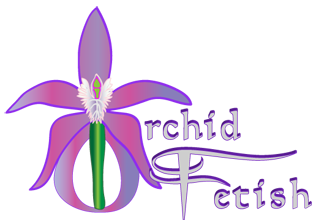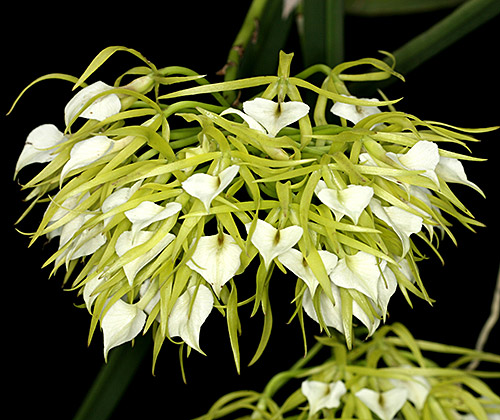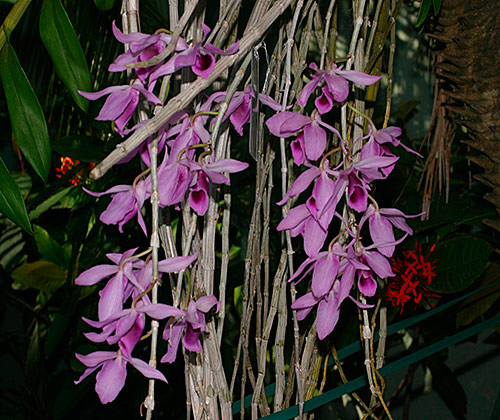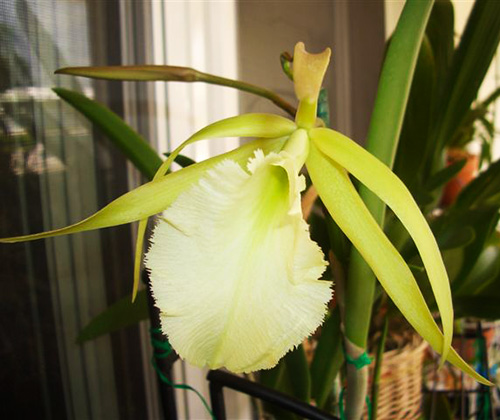Brassavola Species Orchid
The Star Orchid
The B rassavola orchid is a genus of approximately 20 orchids, and the name comes from a Venetian nobleman and botanist, Dr. Antonio Musa Brassavola. These star shaped orchid species are native to the flat plains of Central America and tropical South America. They are epiphytes. which are plants that grow on top of other plants, but do not use them as a source of nutrients or water, instead absorbing their nutrients from the air. A few are lithophytes, which feed off moss, nutrients in rain water, litter, and even their own dead tissue. A single flower bud or a cluster of a few flowers at the top is accompanied by succulent leaves that grow on an elongated pseudo bulb, which is the thickened portion of the stem of many orchids, functioning as a water and food storage device. The flowers usually vary from 1 to 5 inches in diameter, and range in colors from a greenish-white, to white, to yellow with brown markings. In order to attract the appropriate moth for pollination, the Brassavolas’ release their citrus scents in the evening.Brassavola are generally a beginner's level orchid in terms of their difficulty to grow. This is mainly because they are more drought tolerant than many species and can handle more neglect than fussier species (vandas, I'm looking at you). Unfortunately, for such an easy orchid with so many great attributes, they are woefully under-represented in the mainstream orchid trade. Look for Brassavola orchids at specialty greenhouses, orchid shows or consider purchasing them online. Brassavola are fast-growing orchids and will quickly begin to yield divisions to increase your collection or make your orchid-loving friends very happy.
Light
Brassavolas prefer light that is similar to the Cattleya orchids light requirements: bright light, but no direct sun. if you have a light meter, anywhere from 2000-3000 foot candles is ideal. Keep an eye on the air circulation; this aspect is important when caring for all orchids.Brassavola orchids typically light fairly strong, bright light, even with some direct sunlight. A healthy Brassavola has mottled leaves, with slight reddish marks on the leaves. Leaves that are deep green typically signify a plant that isn't getting enough light, so the plant should be moved to a brighter location. Brassavola prefer 2,500 to 4,000 fc light intensity. A south-facing window is frequently a perfect home. Brassavola orchids typically light fairly strong, bright light, even with some direct sunlight. A healthy Brassavola has mottled leaves, with slight reddish marks on the leaves. Leaves that are deep green typically signify a plant that isn't getting enough light, so the plant should be moved to a brighter location. Brassavola prefer 2,500 to 4,000 fc light intensity. A south-facing window is frequently a perfect home.
Temperature
Brassavola prefer intermediate to warm temperatures and will bloom better on the warmer end of the scale. Nothing smells as wonderful as a blooming Brassavola on a summer's night.
Water & Humidity
Prefers frequent watering while in active growth but to dry out in between. Prefers to stay slightly on the dry side after flowering. tubular leaves on Brassavola are designed to reduce water transpiration, making them more drought tolerant than many other orchids. As a result, the plants need less humidity and less frequent water than many other epiphytic orchids. As with all orchids, the frequency of watering depends on your growing culture. Mounted Brassavola orchids can be watered several times a week during the growing cycle, while potted Brassavola orchids should be watered thoroughly weekly. Drooping or wrinkled leaves signal water stress and you should water the plant as soon as possible. The tubular leaves on Brassavola are designed to reduce water transpiration, making them more drought tolerant than many other orchids. As a result, the plants need less humidity and less frequent water than many other epiphytic orchids. As with all orchids, the frequency of watering depends on your growing culture. Mounted Brassavola orchids can be watered several times a week during the growing cycle, while potted Brassavola orchids should be watered thoroughly weekly. Drooping or wrinkled leaves signal water stress and you should water the plant as soon as possible.
Feeding
Brassavola orchids send out several flushes of leaves throughout the year and healthy plants are year-round bloomers. As a result, the plant should be fed throughout the year with a weak fertilizer solution (1/4 strength weekly). Many growers fashion "fertilizer balls" from nylon hose and controlled-release pellets, then tie the ball of pellets over the plant, thus providing a small dose of fertilizer every time the plant is watered. Nylon fertilizer balls will last a few months.
Potting
Brassavola adapt well to mounted culture and will thrive mounted on fern plaques or in mounted baskets. Basket-grown Brassavola can quickly outgrow their original basket and form a specimen plant that completely covers the original container. Don't bother repotting or remounting larger Brassavola, but feel free to take divisions and rapidly multiply your plant stock. If you're potting them in containers, use a standard fast-draining orchid mix, such as those composed of expanded clay pellets, charcoal and pine bark chips.Needs quite a bit of air around its roots. Does best mounted on cork or coconut but also does well in bark in clay pots.




